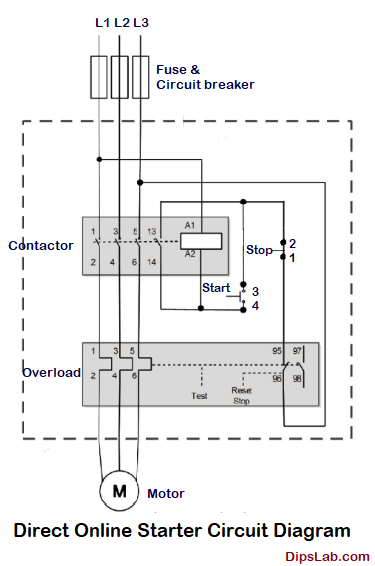
In this tutorial, we are going to study the direct online (DOL) motor starter with working principle, construction, wiring diagram, pros and cons, and applications.
Let’s start from basics…
What is Direct Online (DOL) Starter?
Why do we use starter in motor?
In induction motor draw a high amount of starting current this starting current up to 6 to 8 times of full load current.
The high starting current causes excessive voltage drop, motor winding damage, tripping of protective devices.
In order to avoid this damages, we use different methods to reduce the starting current using the motor starter.
Direct online (DOL) starter is the simplest and cheapest method using for starting method.
This starter used up to 5HP motor depending upon the class of insulation motor (for example- small motors, compressors, small water pumps, fans, blowers, conveyors, etc.).
Working Principle of DOL Starter
When we apply supply voltage to coil get energized, it produces electromagnetic field due to this
the plunger of the contactor will move due to these contacts get closed (NC) hence three-phase supply becomes available to the motor.
The switch used for turning ON or OFF the power supply can be of any type such as rotary, level, float, etc.
Construction and Wiring Diagram
Control circuit of direct online starter
From the following direct online motor starter wiring, three-phase supply (L1, L2, L3) supply connected to the main contractor of contact (1,3,5) normally in open (NO) position.
The contact of 13-14 is auxiliary contact normally open contact NO, when coil energizes it becomes normally close (NC). (This contact used for holding purposes).

- Contactor Coil Connection:
The terminal of A1 is connected to the direct line (L1). And terminal of A2 is connected through the control circuit (from 95-96 NC contact of OLR and start button).
- Overload relay connection:
OLR connecting between the main contactor and motor connections. The 95-96 NC connection is connected to the A2 coil terminal through the start and stop button.
Working of direct online motor starter
When we press the start button contactor coil gets activated through the A2 terminal. A1 is directly connected to L1.
A2 terminal gets supply from OLR NC contact (95-96)- stop button (1-2)start button (3-4)-A2 terminal.
Rated supply 420V get coil energizes and the magnetic field is produced and plunger will move, the main contactor of contacts hold and motor get supply at the same time auxiliary contact 13-14 it becomes NC.
This auxiliary contact we used for holding this circuit. When we release the start button it holds the circuit and supply flow this way, OLR NC contacts (95-96)-Auxiliary contact (13-14)-A2 terminal.
When push the stop button control circuit of the starter will disconnect the coil supply, the plunger moves to normal position, contact becomes in open and the motor supply is disconnected.
Advantages & Disadvantages of DOL Starter
Listing are the following pros and cons…
(Pros) Advantages of direct online starter
- DOL starter is the most economical and cheapest starting method.
- Easy to understand and troubleshooting.
- It provides 100% starting torque.
- This starter connects the supply to the delta winding of the motor.
(Cons) Disadvantages of direct online starter
- There is no control over the starting torque and current.
- This DOL starter causes a significant in dip voltage. Therefore, it is suitable for only small motors.
- High starting torque reduces the lifespan of an electric motor or machine.
- Very high starting current (6 to 8 times of full load current).
Applications of Direct Online Motor Starter
- The direct online starter is used for the low-power rating motor (below 5HP).
- DOL starter is used where, the high starting current does not damage the motor winding.
Appreciate the effort. Complex topics explained in a very simple way.
Appreciate what you do here.
Very nice information sir in easy language.
Thank you sir for sharing your knowledge with us in understandable language.
Thank u sir what about star delta discussion
Glad!